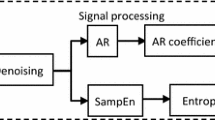Abstract
In this paper, a new feature extraction method for electroencephalogram (EEG) signal analysis is suggested. This scheme is based on the spectral correlation function (SCF), which presents a second-order statistical description in the frequency domain. The SCF of each EEG signal is computed by using an efficient computational algorithm, which is called the FFT accumulation method. To choose an efficient statistical model for the SCF coefficients of EEG signals, their statistical properties are surveyed at different regions of bi-frequency plane. We show that the SCF coefficients are heteroscedastic, and the generalized autoregressive conditional heteroscedasticity (GARCH) is considered as one of their proper model. The GARCH parameters of each SCF sub-band are calculated and then are utilized for EEG classification. Hence, the resultant features fed to a multilayer perceptron classifier. The results clearly indicate that the performance of the new method in EEG classification outperforms the previous studies.




Similar content being viewed by others
References
Übeyli, E.D.: Statistics over features: EEG signals analysis. Comput. Biol. Med. 39, 733–741 (2009)
Adeli, H., Zhou, Z., Dadmehr, N.: Analysis of EEG records in an epileptic patient using wavelet transform. J. Neurosci. Methods 123, 69–87 (2003)
Orhan, U., Hekim, M., Ozer, M.: EEG signals classification using the K-means clustering and a multilayer perceptron neural network model. Expert Syst. Appl. J. 38, 13475–13481 (2011)
Orosco, L., Garces Correa, A., Laciar, E.: Multiparametric detection of epileptic seizures using empirical made decomposition of EEG records. In: 32nd Annual International Conference of the IEEE EMBS (2010)
Übeyli, E.D.: Combined neural network model employing wavelet coefficients for EEG signals classification. Digit. Signal Process. 19, 297–308 (2009)
Amirani Chehel, M., Beheshti, A.A.: Evaluation of the texture analysis using spectral correlation function. Fund. Inf. 95, 249–262 (2009)
Xu, Q., Zhou, H., Wang, Y., Huang, J.: Fuzzy support vector machine for classification of EEG signals using wavelet-based features. Mach. Eng. Phys. 31, 858–865 (2009)
Polat, K., Günes, S.: Artificial immune recognition system with fuzzy resource allocation mechanism classifier, principal component analysis and FFT method based new hybrid automated identification system of EEG signals. Syst. Appl. 34, 2039–2048 (2008)
Bican, C., Woolfson, M.S.: Time–frequency analysis of sort segments biomedical data. Med. Signal Process. 147, 368–373 (2000)
Shuren, Q, Zhong, J.: Extraction of features in EEG signals with the non-stationary signal analysis technology. In: Proceeding of the 26th Annual International Conference of IEEE EMBS (2004)
Ocak, H.: Automatic the detection of epileptic seizures in EEG using discrete wavelet transform and approximate entropy. Expert Syst. Appl. 36, 2027–2036 (2009)
Zarjam, P., Mesbah, M., Boashash, B.: Detection of newborns EEG seizure using optimal features based on discrete wavelet transform. In: Proceedings of the Fourth IEEE International Conference on Acoustic Speech and Signal Processing, pp. 265–268 (2003)
Mousavi, S.R., Niknazar, M., Vosoughi Vahdat, B.: Epileptic seizure detection using AR model on EEG signals. In: Proceeding of the IEEE Conference (2008)
Subasi, A., Gursoy, M.: IEEG signal classification using PCA, ICA, LDA and support vector machines. Expert Syst. Appl. 37, 8659–8666 (2010)
Amirani Chehel, M., Beheshti, A.A.: Texture classification using of cyclic spectral function. In: Proceeding of the First International Congress on Image and Signal Processing CISP, vol. 2, pp. 834–838 (2008)
Gardner, W.A.: The spectral correlation theory of cyclostationary time series. Signal Process. 11, 13–36 (1986)
Gardner, W.A.: Measurement of spectral correlation. IEEE Trans. Acoust. Speech Signal Process. ASSP 34, 1111–1123 (1986)
Gardner, W.A.: Statistical Spectral Analysis: A Nonprobabilistic Theory. Prentice-Hall, Englewood Cliffs, NJ (1987)
Browm, W.A.: On the theory of cyclostationary signals. Ph. D. dissertation, Univ, California, Davis (1987)
Gardner, W.A.: Spectral correlation function of modulated signals: part I-analog modulation. IEEE Trans. Commun. 35, 584–594 (1987)
Gardner, W.A., Browm, W.A., Chen, C.K.: Spectral correlation function of modulated signals. Part II- Digital modulation. IEEE Trans. Commun. 35, 595–601 (1987)
Roberts, R.S., Brown, W.A., Loomis, H.: Computationally efficient algorithms for cyclic spectral analysis. IEEE Signal Process. Mag. 8, 38–49 (1991)
Amirmazlaghani, M., Amindavar, H.: Two novel Bayesian multiscale approaches for speckle suppression in SAR images. IEEE Trans. Geosci. Remote Sens. 48, 2980–2993 (2010)
Amirmazlaghan, M., Amindavar, H., Moghaddamjoo, A.: Speckle suppression in SAR images 2-D GARCH model. IEEE Trans. Image Pprocess. 18, 250–259 (2009)
Sabusi, A.: EEG signal classification using wavelet feature extraction and a mixture of expert model. Expert Syst. Appl. 32, 1084–1093 (2007)
Srinivasan, V., Eswaran, C., Sriraam, N.: Artificial neural network based epileptic detection using time-domain and frequency-domain features. J. Med. Syst. 29, 647–660 (2005)
Tazallas, A., Tsipouras, M., Fotiadis, D.: A time–frequency based method for the detection of epileptic seizures in EEG recordings. In: 20th IEEE International Symposium on Computer-based Medical Systems CMS’07, pp. 135–140 (2007)
Crochier, R., Rabiner, L.: Multirate Digital Signal Processing. Prentice-Hall, Englewood Cliffs, NJ (1983)
Engle, R.F.: Autoregressive condition heteroscedasticity with estimate of the variance of UK inflation. Econometrical 50, 987–1008 (1982)
Amirmazlaghani, M., Amindavar, H.: EMG signals denoising via Bayesian wavelet shrinkage based on GARCH modeling. In: IEEE conference ICASSP, pp. 469–471 (2009)
Bollerslev, T.: Generalized autoregressive condition heteroscedasticiy. J. Economet. 31, 307–327 (1986)
Andrzejak, R., Lehnertz, G.K., Mormann, F., Rieke, C., David, P., Elger, C.E.: Indications of nonlinear detection and finite-dimensional structures in time series of brain electrical activity Dependence on recording region and brain state. Phys. Rev. E 64(6), 061907 (2001). Institute of Medical Biometry, Information and Epidemiology of the ‘Medizinische Einrichtungen der Universität Bonn’, http://www.meb.uni-bonn.de/epileptology/science/physik/eeg.data.html
Choqueuse, V., Yao, K., Collin, L., Burel, G.: Blind detection of the number of communication signals under spatially correlated noise by ICA and K-S test. In: IEEE Conference ICASSP (2008)
Fukunaga, K.: Introduction to Statistical Pattern Recognition, 2nd edn. Academic Press Professional, New York (1990)
Conflict of interest
The authors declare that they have no conflict of interest.
Author information
Authors and Affiliations
Corresponding author
Rights and permissions
About this article
Cite this article
Mihandoost, S., Amirani, M.C. EEG signal analysis using spectral correlation function & GARCH model. SIViP 9, 1461–1472 (2015). https://doi.org/10.1007/s11760-013-0600-9
Received:
Revised:
Accepted:
Published:
Issue Date:
DOI: https://doi.org/10.1007/s11760-013-0600-9




